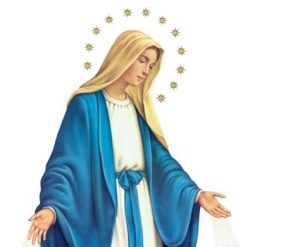Mass on the 15th August is at 10.00 in Our Lady of the Rosary Church.
The Solemnity of the Assumption of the Blessed Virgin Mary was already being celebrated on 15 August in the 5th century. It bore the sense of Our Lady’s “Birth into heaven”, or in the Byzantine tradition, her “Dormition”. The feast began to celebrated in Rome in the middle of the 7th century. It was not until 1 November 1950, that Pope Pius XII proclaimed the Dogma of Mary’s assumption body and soul into heaven. In the Apostles’ Creed, we profess our faith in the “Resurrection of the body” and in “life everlasting”. This is the ultimate goal and meaning of our life’s journey. This promise of faith is already accomplished in Mary, who is the “sign of sure hope and comfort” (Preface). It is a privilege granted to Mary, and closely connected to her being the Mother of Jesus. Since death and the corruption of the human body are consequences of sin, it was not right that the Virgin Mary – who is free from sin – should be affected by this natural law. Hence the mystery of her “Dormition” or “Assumption into heaven”. The fact that Mary has already been assumed into heaven is a reason to celebrate, to rejoice, to hope in the “already and the not yet”. One of God’s creatures – Mary – is already in heaven. With her, and like her, we too, who are God’s creatures, will one day be there too. Mary’s destiny, united to the transfigured and glorious body of Jesus, is, therefore, the destiny of all those who are united to the Lord Jesus in faith and love. It is interesting to note that the liturgy – through the biblical texts taken from the Book of Revelation and the Gospel according to Luke (the Canticle of the Magnificat) – helps us, not so much to reflect, as to pray. In fact, the Gospel suggests that Mary’s mystery be read in the light of her prayer, the Magnificat, that is, through the lens of gratuitous love that extends from generation to generation, and the predilection of the least and the poor. Its choicest fruit, you could say its masterpiece, is Mary, a mirror in which the entire people of God can see its own features reflected. The Solemnity of the Assumption of the Blessed Virgin Mary, body and soul, is an eloquent sign of how not only the “soul” but also the “body” is included in the biblical observation that “God found it very good” (Gn 1:31), so much so that in the Virgin Mary, “our flesh” would be assumed into heaven. This does not exempt us from committing ourselves to life here on earth, but rather that with our gaze fixed on the goal, on Heaven, our Homeland, we are driven to commit ourselves during our present life to reflect the Magnificat: to rejoice in God’s mercy, to be attentive to all our brothers and sisters we meet along the way, beginning with the weakest and most vulnerable.
